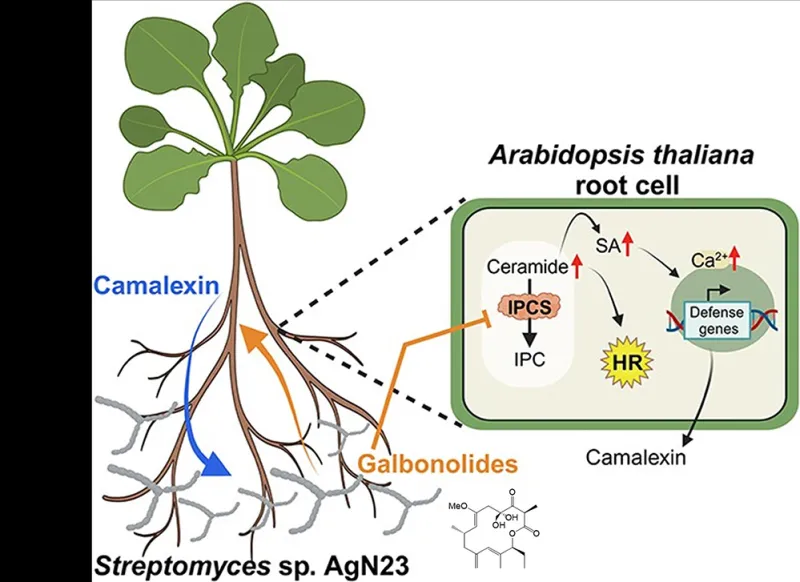Follow us on Google News (click on ☆)
The rhizosphere, the area near plant roots, is an ecological niche characterized by the presence of numerous microorganisms. This collection of microorganisms forms the microbiota, whose activity is essential for plant nutrition and their resistance to diseases.

The AgN23 strain produces specialized metabolites, called galbonolides, that inhibit the activity of IPC synthase (IPCS), an enzyme involved in sphingolipid (ceramide) metabolism. Disruption of ceramide metabolism triggers immune responses, including the production of antimicrobial metabolites such as camalexin in the model plant Arabidopsis thaliana. The accumulation of camalexin in the rhizosphere, in turn, promotes the development of AgN23, further enhancing its biological activity.
© Dumas, 2024
The structuring of this microbiota is ensured by complex communication mechanisms, particularly biochemical, between plants and microorganisms on the one hand and between microorganisms on the other. Decoding these mechanisms is a major challenge for constructing and rationally managing plant microbiota, especially for cultivated plants.
In previous work, scientists identified a bacterial strain, AgN23, capable of inducing strong immune responses in plants, thereby protecting them against attacks by pathogenic microorganisms.
In an article published in the journal The ISME Journal, scientists studied the mode of action of this strain. They discovered that it produced a particular class of compounds called galbonolides.
The role of galbonolides was investigated through molecular genetics and biochemistry approaches, leading to the conclusion that these molecules, by interfering with sphingolipid metabolism, induce the production of antimicrobial defense molecules by the roots. More unexpectedly, these studies revealed that the development of AgN23 around the roots is stimulated by the production of these plant compounds, further reinforcing the bacterium's protective role.
This research thus identified that bacteria produce compounds that manipulate plant immune systems to promote their own development in the rhizosphere. These findings will eventually contribute to the rational design of microbial consortia for plant health.
Reference:
Root associated Streptomyces produce galbonolides to modulate plant immunity and promote rhizosphere colonization.
Nicolle, C., Gayrard, D., Noël, A., Hortala, M., Amiel, A., Grat-Simeone, S., Le Ru, A., Marti, G., Pernodet, J-L., Lautru, S., Dumas, B. and Rey, T (2024).
June 19, 2024, The ISME Journal, DOI: https://doi.org/10.1093/ismejo/wrae112